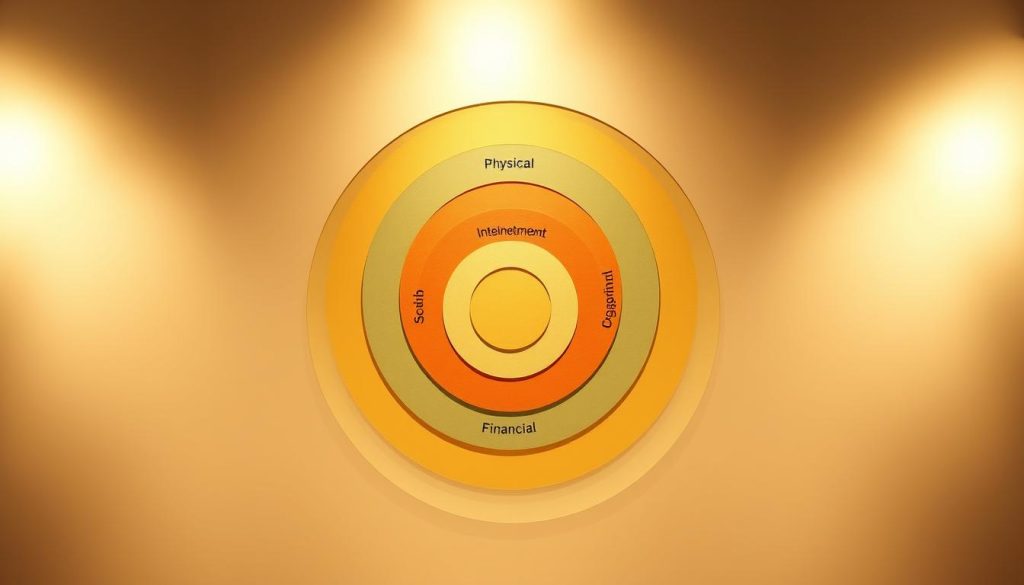Imagine a day when life’s demands leave you feeling drained, yet something’s still missing. Wellness is more than just avoiding illness; it’s about thriving. Whether you’re juggling work, family, or personal goals, your well-being is crucial.
This guide is for anyone ready to make lasting changes. Wellness isn’t a destination; it’s the journey to feeling more alive, one step at a time.
Today, wellness means caring for your mind, body, and spirit. It’s about finding balance in a world that often pushes you out of it. No matter where you start, this journey is about progress, not perfection.
Let’s explore how small shifts—like mindful moments or nourishing meals—can build a foundation for lifelong well-being.
Key Takeaways
- Wellness focuses on holistic health beyond physical fitness.
- Small daily actions create big improvements in well-being.
- Everyone, regardless of background, can embrace wellness practices.
- Modern wellness prioritizes mental, emotional, and social health equally.
- Consistency, not perfection, drives sustainable change.
Understanding the Foundations of Wellness
Wellness is more than just staying healthy. It’s about finding balance in all parts of life. Let’s dive into what makes it different from traditional health views.

The Eight Dimensions of Wellness Explained
True wellness covers eight key areas:
- Physical: Exercise, nutrition, and sleep
- Emotional: Managing stress and building resilience
- Social: Healthy relationships and community ties
- Intellectual: Lifelong learning and creativity
- Spiritual: Values, purpose, and meaning
- Environmental: Safe, sustainable living spaces
- Occupational: Job satisfaction and work-life balance
- Financial: Money management and stability
How Wellness Differs from Simply Being Healthy
| Health | Wellness |
|---|---|
| Absence of disease | Active pursuit of thriving |
| Medical focus | Whole-life perspective |
| Symptom management | Proactive lifestyle choices |
Why a Holistic Approach Matters
Ignoring any one area can upset the balance. For instance, ignoring finances can lead to emotional stress. Holistic living means tackling all areas with equal care. Studies show people who do this are 34% happier (Journal of Health Psychology, 2022).
Creating Your Personal Wellness Vision
Starting a wellness journey means figuring out what’s important to you. Your wellness vision isn’t about following trends or what others think. It’s about making a plan that fits your goals and values. This journey of self-improvement begins with looking at your current habits and dreams.

- Identify core values: What makes you happy or peaceful? Make these your top priorities.
- Assess current habits: Keep track of your daily routines to find areas for improvement in wellness.
- Set actionable goals: Make your insights into clear, reachable steps, like “30 minutes of movement daily” or “weekly mindfulness practice.”
“Wellness without personalization is like a recipe without ingredients.”
Think about a working parent wanting to balance family and self-care, or a student focusing on sleep and study breaks. Your vision might be about physical health, emotional balance, or creative activities—whatever makes you feel good. Ask yourself, “What does a fulfilling day look like?” to get ideas. Remember, your plan should be flexible. Change it as needed to keep it helpful, not stressful.
Start today: Get a notebook and begin writing. Your wellness vision is your guide to a healthier, more meaningful life.
The Mind-Body Connection: Strengthening Your Mental Wellness
It’s important to know how your thoughts and body sensations work together. Small actions like mindfulness or moving every day can make a big difference. Let’s look at simple ways to add this connection to your daily life.
Effective Stress Management Techniques
Stress doesn’t have to rule your life. Here are some proven ways to handle it:
- Deep Breathing: Breathe in for 4 counts, hold for 4, then breathe out for 6. Do this 5 times.
- Progressive Muscle Relaxation: Tighten and then relax muscles from your toes to your shoulders to reduce tension.
- Cognitive Reframing: Question negative thoughts by asking, “Is this thought true?”
| Technique | Key Benefits |
|---|---|
| Deep Breathing | Reduces cortisol levels |
| Progressive Muscle Relaxation | Releases physical tension |
| Cognitive Reframing | Shifts unhelpful thought patterns |
Mindfulness Practices for Everyday Life
- Take mindful pauses: Pay attention to what you feel while eating or walking.
- Use a 5-minute guided meditation app like Headspace or Calm every day.
- Write in a journal for 5 minutes to track your thoughts and feelings.
Building Emotional Resilience
Resilience grows with regular effort. Here are some tips:
- Practice gratitude by noting 3 positive moments each day.
- Set limits to protect your energy—say “no” to things that aren’t important.
- Stay connected with supportive friends or a therapist for help.
When to Seek Professional Support
“Asking for help is a sign of strength, not weakness.” — American Psychological Association
If stress is too much to handle or interferes with your daily life, seek help from a licensed therapist. Online services like BetterHelp or your insurance’s network can provide personalized support.
Nutrition as a Cornerstone of Wellness
Choosing the right foods is more than avoiding empty calories. It’s about fueling your body to thrive. Nutrient-rich meals can sharpen focus, stabilize moods, and boost vitality. Start by prioritizing whole foods like leafy greens, nuts, and colorful fruits packed with vitamins and minerals.
Food Choices That Boost Energy and Mood
Omega-3 fatty acids in salmon or flaxseeds support brain health. Complex carbs like quinoa or sweet potatoes provide steady energy. Dark chocolate (in moderation!) offers antioxidants that reduce stress hormones.
Pair these with fermented foods like yogurt or sauerkraut. They nourish gut health, which directly impacts mental well-being.
Meal Planning for Optimal Health
Meal prep simplifies eating well. Try batch-cooking grains or roasting veggies for quick lunches. A balanced plate includes ½ vegetables, ¼ protein (like grilled chicken or tofu), and ¼ whole grains.
Swap sugary snacks for apple slices with almond butter. This combo keeps blood sugar stable and cravings at bay.
Understanding Intuitive Eating
Intuitive eating encourages listening to hunger cues instead of rigid rules. Eat until satisfied, not stuffed, and savor every bite. Research shows this approach reduces guilt and improves long-term health outcomes.
Experiment with mindful eating: chew slowly and focus on flavors. This helps reconnect with your body’s needs.
Physical Activity: Finding Joy in Movement
Moving your body doesn’t have to feel like a chore. fitness routines can match your hobbies, nature, or daily tasks. Dancing in the kitchen, walking the dog, or gardening can all be fun. These activities help improve both your physical and mental health.
- Try yoga for flexibility and calm.
- Go for brisk walks to boost mood.
- Join a dance class to spark creativity.
“Movement is medicine for the mind and body.” — World Health Organization
Find activities that fit your life. Strength training builds muscle, while hiking improves balance. Even small actions, like taking the stairs, count. Feeling overwhelmed? Begin with just 10 minutes a day. Celebrate your progress, not perfection.
Hit a roadblock? Try these tips:
- Schedule workouts like any other appointment.
- Listen to podcasts or music while moving.
- Explore adaptive options if you have mobility issues.
Every step you take builds resilience and energy. Let curiosity lead you to new ways to move. Your body and mind will appreciate it.
Sleep and Recovery: The Forgotten Wellness Essential
Sleep is often overlooked in wellness talks, but it’s key for health and well-being. Without enough rest, the body can’t heal, and the mind gets foggy. Making sleep a priority is not a luxury—it’s a must for a good life.
Creating the Ideal Sleep Environment
Your bedroom should be a place for calm. Here’s how to make it:
- Temperature: Keep it cool—around 65°F (18°C) for better sleep cycles.
- Light: Use blackout curtains or a sleep mask to block disruptive light.
- Noise: Try a white noise machine or earplugs to minimize disturbances.
- Bedding: Choose a supportive mattress and pillows to align your spine.
Developing a Restorative Nighttime Routine
A consistent routine helps your body get ready for sleep. Follow these steps:
- Unplug from screens 1 hour before bed to reduce blue light exposure.
- Take a warm shower or read a book to ease into relaxation.
- Dim bedroom lights to boost natural melatonin production.
Addressing Common Sleep Disruptors
Common obstacles like caffeine or stress can mess with sleep. Here’s how to handle them:
| Disruptor | Solution |
|---|---|
| Late-night caffeine | Avoid coffee and tea after 2 PM. |
| Stress overload | Write down worries in a journal or try 5-minute breathing exercises. |
| Irregular schedules | Set a consistent bedtime and wake time, even on weekends. |
Small changes in environment and habits can make a big difference in sleep quality. Better rest boosts every part of your wellness journey.
Social Wellness: Nurturing Meaningful Connections
Healthy relationships boost our mental health and make us feel like we belong. Studies prove that people with strong social bonds are more resilient and live longer. It doesn’t matter if you’re an introvert or extrovert; making connections that add value to your life is crucial for wellness.
“Loneliness can be as harmful to health as smoking 15 cigarettes a day.” — Dr. Julianne Holt-Lunstad, Brigham Young University
To start, focus on self-care by choosing meaningful interactions. Make time for regular calls with family and friends or find groups that match your interests. Here are some tips:
- Listen actively: Ask questions and avoid distractions
- Share vulnerability: Open conversations deepen trust
- Attend local events: Libraries, parks, and community centers offer free gatherings
Technology can make it hard to connect. Make sure to spend quality time with people face-to-face. Here’s how:
- Set daily social media time limits
- Opt for video chats over texts for deeper bonds
- Unfollow accounts that create social pressure
Getting involved in causes you care about can give you a sense of purpose. Helping out at community gardens, animal shelters, or neighborhood cleanups can grow your social circle and improve your mood. Every interaction, no matter how small, like saying thank you to a coworker or greeting a neighbor, strengthens your social network. Social wellness is about building relationships that nourish your heart and mind, not just about having many friends.
Incorporating Wellness Into Your Daily Routine
Creating a daily wellness routine doesn’t need big changes. Small, regular habits can make your day more mindful and intentional. Even if you’re busy, you can still find time for practices that care for your body and mind.
Small daily choices create lasting wellness.
Morning Rituals to Start Your Day Right
Start with 5 minutes of mindful breathing to calm yourself. Try gentle yoga or a short walk to wake up your senses. Writing down 3 things you’re grateful for or making a healthy breakfast can set a good mood. These small actions help you live more mindfully.
Workday Wellness Strategies
- Micro-breaks: Take 2-minute mindful pauses hourly—focus on breath or stretch at your desk.
- Mindful movement: Chair-based exercises like shoulder rolls or standing leg lifts boost energy without leaving your workspace.
- Healthy choices: Keep almonds, fruit, or dark chocolate nearby for mindful snacking. Hydrate with water infused with lemon or cucumber.
Evening Practices for Unwinding
End your workday by turning off screens an hour before bed. A warm bath with lavender oil or 10 minutes of guided meditation can help relax you. Reflecting on your day in a journal can also help. These steps help your body get ready for a good night’s sleep.
Remember, being consistent is more important than being perfect. Start with one habit and add more as you go. Wellness is about being flexible and kind to yourself.
Tracking Your Wellness Journey: Measuring Progress Without Obsession
Tracking your wellness progress is key to growth, but don’t get too caught up in numbers. Embrace holistic living by mixing data with your feelings. Start small, like keeping a journal or using an app to track energy, sleep, and mood.
- Keep a weekly journal to record moments of joy or stress.
- Use apps that track steps or sleep but set time limits to avoid overchecking.
- Schedule monthly check-ins to reflect on goals and adjust plans.
“Wellness tracking should feel like a conversation, not a report card,” says Dr. Emily Carter, a certified wellness coach. “Ask yourself, ‘Does this help me feel better?’ not ‘Did I hit every number?’”
Look for patterns in your self-care routine. Did meditation improve focus? Did walking more lift your mood? These changes are just as important as numbers.
Don’t compare your journey to others—your path is unique. When you hit a setback, see it as a chance to learn, not a failure. Celebrate small victories, like a good night’s sleep or a tough workout. Use setbacks to improve, not to give up. A balanced approach ensures tracking enhances your well-being, not causes stress.
True progress is feeling stronger, calmer, or more connected. Keep your tools simple, stay curious, and celebrate every step of the way.
Conclusion: Embracing Wellness as a Lifelong Journey
Wellness is a journey shaped by daily choices. Each step, like adjusting meals or moving more, adds to lasting well-being. Life’s changes may shift priorities, but staying flexible ensures progress continues.
Small actions add up. A mindful pause, a walk, or checking in with yourself can spark positive change. Challenges are natural, but adapting practices or seeking support keeps the path forward. Focus on consistency, not perfection.
Start where you are. Focusing on one area at a time builds momentum. Wellness isn’t static; it grows with you. Every effort counts toward a healthier, more balanced life. Take the next step today—it’s your journey, and every move toward well-being matters.
FAQ
What is wellness, and how is it different from health?
Wellness is more than just being healthy. It’s about living a balanced life. This includes your physical, emotional, and social well-being. It’s about thriving, not just avoiding illness.
How can I create a personalized wellness vision?
Start by thinking about your life and habits. Identify what’s important to you. Set goals that fit your needs. Writing down your goals can help clarify your vision.
What are some effective strategies for managing stress?
To manage stress, try mindfulness and deep breathing. Keep a regular routine and build a support network. Activities like yoga or nature walks can also help.
How can nutrition support my overall wellness?
Good nutrition is key to wellness. It gives your body what it needs to function well. Eating whole foods can boost your energy and mood. Find a healthy eating approach that works for you.
What types of physical activities should I include in my routine?
Choose activities you enjoy. This could be dancing, hiking, or swimming. Aim for a mix of cardio, strength, and flexibility. Make exercise a fun part of your life.
How important is sleep for overall wellness?
Sleep is essential for wellness. It affects your mood and health. A good sleep routine can greatly improve your well-being.
How can I improve my social wellness?
Nurture your relationships and seek new connections. Join community events or try new hobbies. Healthy social media use is also important.
What are morning rituals I can adopt to improve my day?
Start with gentle stretches or meditation. Journaling or a healthy breakfast can also set a positive tone. Small habits can make a big difference.
How can I track my wellness journey without becoming obsessed?
Focus on how you feel, not just numbers. Use check-ins to reflect on your progress. This helps avoid stress and anxiety.
When should I seek professional support for my mental health?
Seek help if self-care isn’t enough. Look for signs like persistent sadness or stress. A mental health expert can offer support and strategies.




